Key takeaways:
- Professional artistry requires dedication, resilience, and a commitment to personal growth beyond mere talent.
- Sculpture offers a unique physical interaction with art that conveys emotion and narrative in ways two-dimensional art cannot.
- Artists face challenges such as self-doubt, financial instability, and the need for visibility in a competitive market.
- Turning passion into a profession involves embracing the business aspects of art and maintaining persistence through rejection.
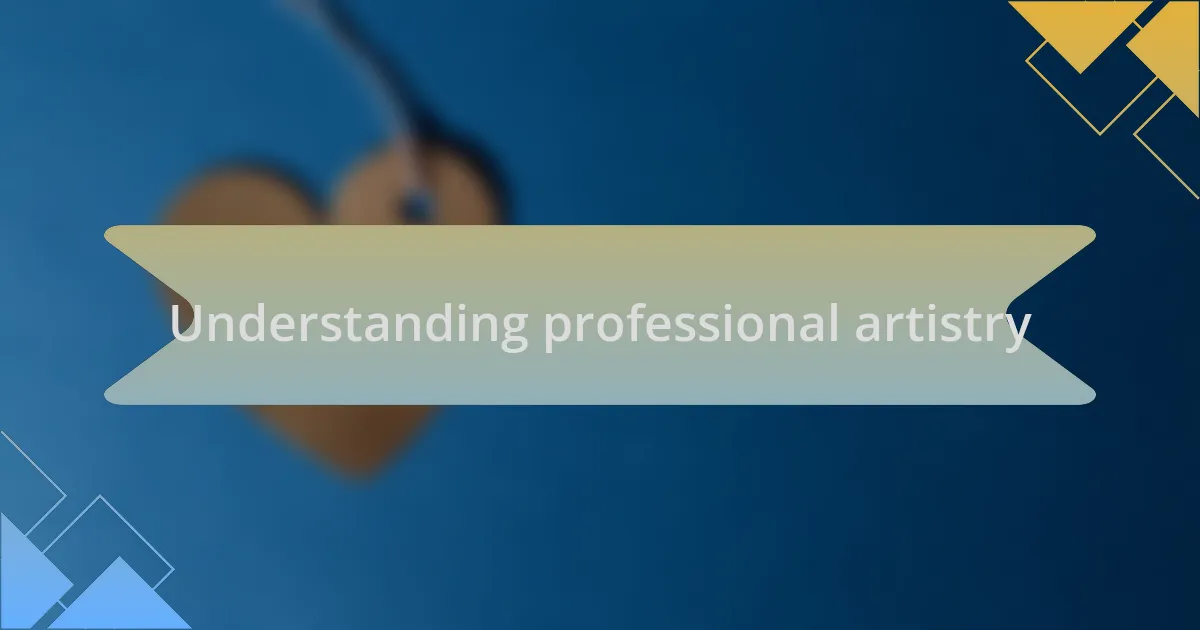
Understanding professional artistry
Understanding professional artistry goes far beyond mere talent; it’s about the dedication and resilience one pours into the craft. I still remember the countless nights spent in my studio, sculpting amidst the chaos, completely absorbed in my work. Those moments of solitude taught me that artistry requires not just skill, but an unwavering commitment to personal growth and exploration.
Have you ever found yourself staring at a piece of art, trying to decode its essence? I often felt that same intrigue when I encountered other artists’ work. It made me realize how each artist infuses their unique perspective and life experiences into their creations. This connection between the artist and the audience forms the heart of professional artistry, transforming individual expression into a shared journey of emotions and ideas.
As I navigated my artistic path, I learned that professionalism in the art world entails more than creating beautiful pieces; it encompasses developing a voice, building a network, and understanding the business side of artistry. The thrill of connecting with a community of fellow artists, exchanging insights, and even receiving critique has been invaluable. It raises an important question: Are we, as artists, willing to embrace the challenges and opportunities that come with professional growth?

Importance of sculpture in art
Sculpture holds a significant place in the art world, offering a tangible representation of artistic vision. I remember the first time I touched a sculpted figure; feeling the texture, the weight, and the intricate details ignited a sense of connection that two-dimensional art could never achieve. It transformed my understanding of space and material, showing me how three dimensions can convey emotion and narrative in profoundly impactful ways.
What truly fascinates me about sculpture is its physicality—it invites viewers to move around it, to engage with it in a way that’s personal and immersive. I still think back to an outdoor exhibition where large sculptures dotted the landscape, each creating a unique dialogue with the environment. This interactive experience fosters a deeper appreciation of art, as it encourages each viewer to forge their own interpretation based on their perspective and surroundings.
Moreover, sculptures often reflect cultural narratives, preserving moments in history that resonate across generations. I once created a piece influenced by my hometown’s struggles and triumphs, hoping to spark conversations about our shared heritage. Isn’t it powerful how a sculpture can serve as a historical anchor, urging us to remember and reflect on our collective experiences? This layered significance underscores why sculpture is vital in the art realm, enriching both individual lives and the broader community narrative.
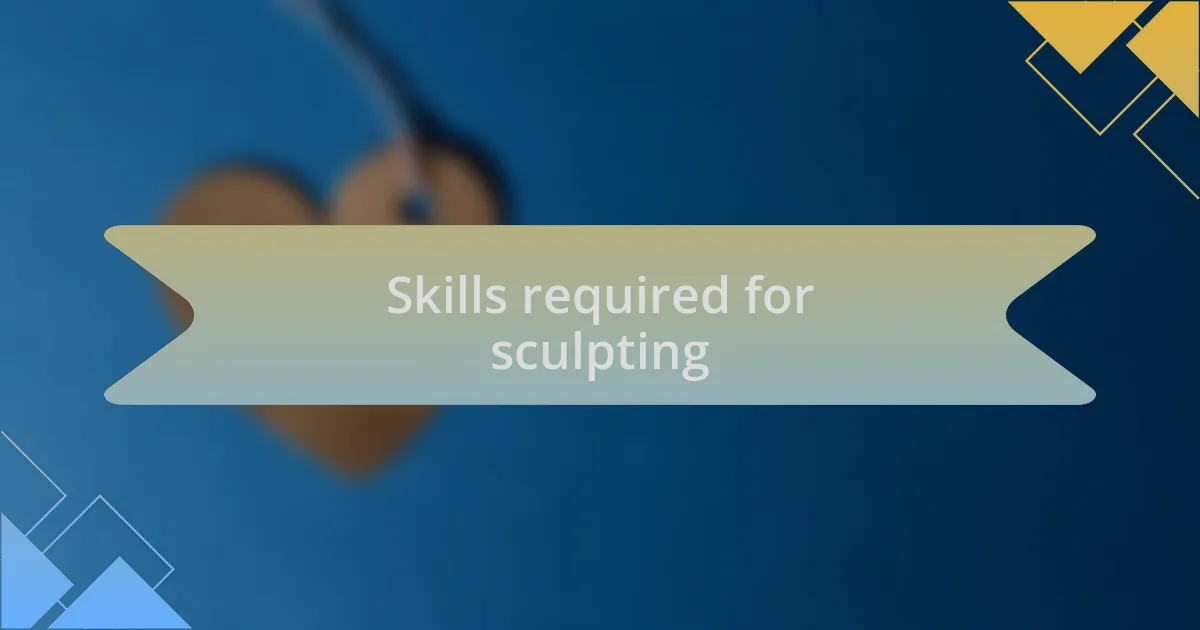
Skills required for sculpting
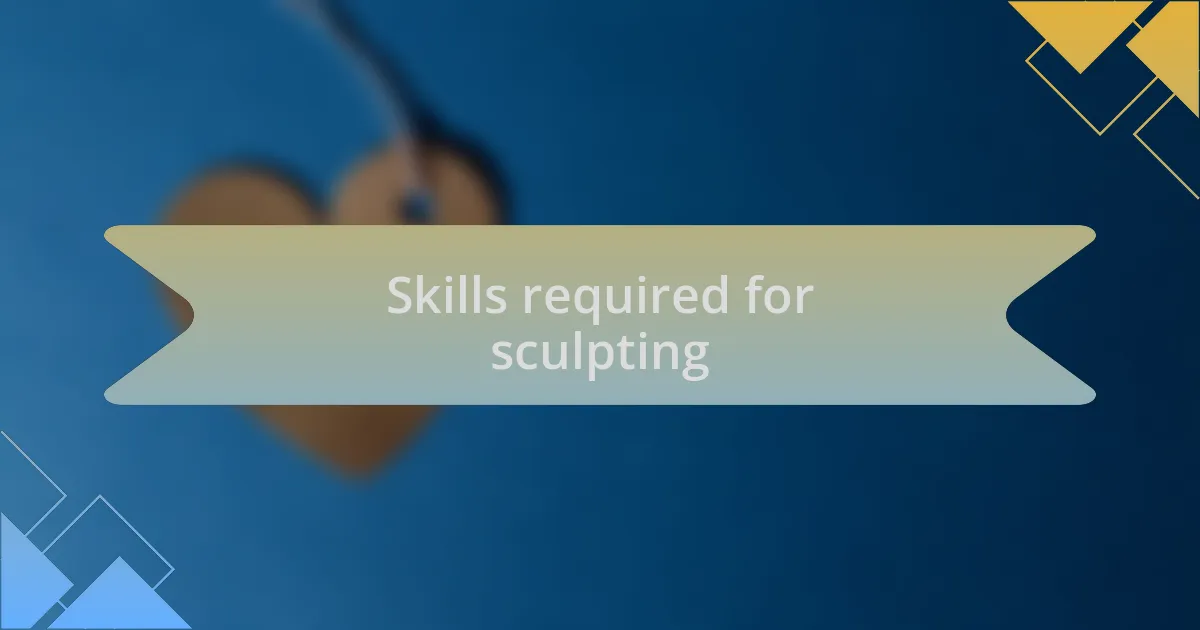
Skills required for sculpting
Developing a keen sense of observation is crucial in sculpture. I remember standing in front of a live model during one of my first classes; every subtle curve and shadow challenged my perception. It taught me to look beyond the surface, to understand form and proportion—skills essential for anyone aiming to create lifelike representations.
Equally important is the ability to work with various materials, as each medium has its own unique properties. When I first experimented with clay, I was surprised by how malleable it felt, while the rigidity of stone required a different approach altogether. This hands-on experience with different materials not only expands an artist’s versatility but also fosters a deeper understanding of how to express ideas through the chosen medium. Have you ever felt the satisfaction of transforming a raw block into something meaningful?
Lastly, technical skills, such as carving and modeling techniques, are fundamental. I fondly recall my early attempts at chiseling marble; the patience and precision required were intimidating yet exhilarating. Learning these techniques not only enhances creativity but also serves as a bridge between imagination and execution, allowing artists to manifest their visions into reality. What experiences shaped your understanding of sculpting skills?
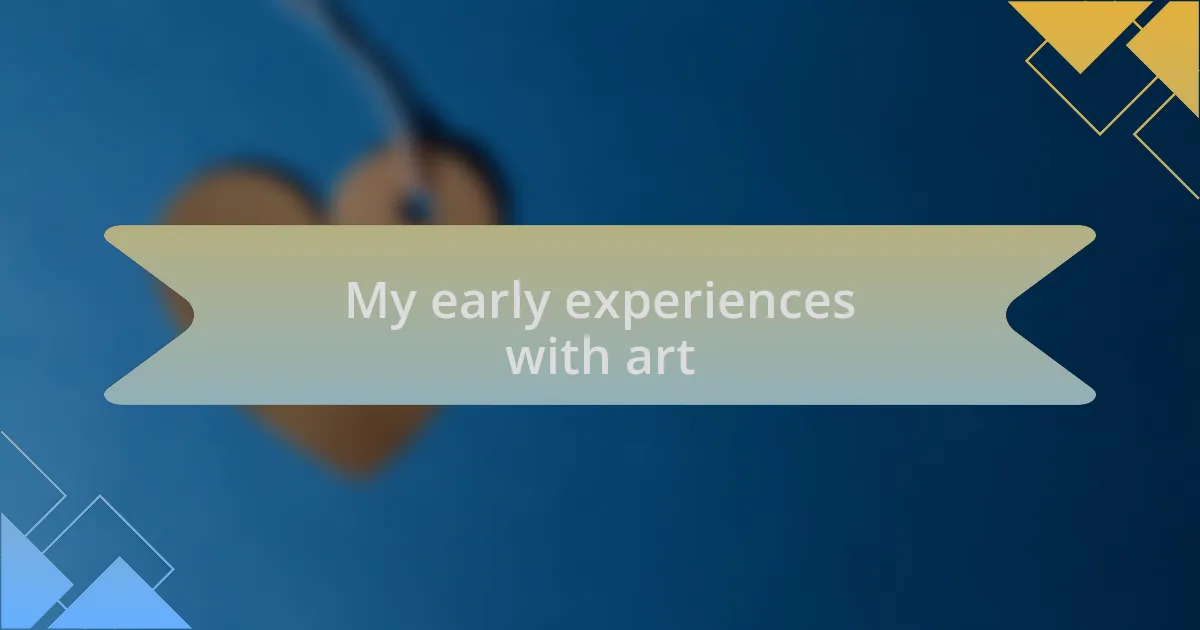
My early experiences with art
Art has always been a part of my life, starting from childhood when I would spend hours doodling on any available surface. I distinctly remember a particular summer day, armed with just a handful of colored pencils and a sketchbook, I attempted to capture the essence of my favorite tree in the backyard. That simple act of translating my feelings onto paper was like a gateway; it sparked a sense of freedom in my creativity that I hadn’t recognized before. Have you ever felt that exhilarating rush when you realize your art can convey emotions?
As I grew older, my fascination with three-dimensional forms took root. I still recall the first time I shaped a piece of air-dry clay in my middle school art class. The tactile nature of the medium drew me in instantly—I could mold it, squish it, and form it into anything my imagination could conjure. That connection to the material was profound, making me realize how tactile experiences could fuel artistic expression. Can you remember the moment a specific medium captivated you?
Another pivotal moment came during a visit to a local art fair. I was mesmerized by the sculptures on display, particularly a bronze piece that seemed to dance in the sunlight. The sheer craftsmanship and emotion that radiated from that sculpture ignited a passion within me. It made me question what stories I wanted to tell through my own art. Inspired, I left that fair with a resolve to explore my artistic path further, realizing the power that sculpture could hold. Have you ever encountered a piece of art that changed your perspective on what you could achieve?
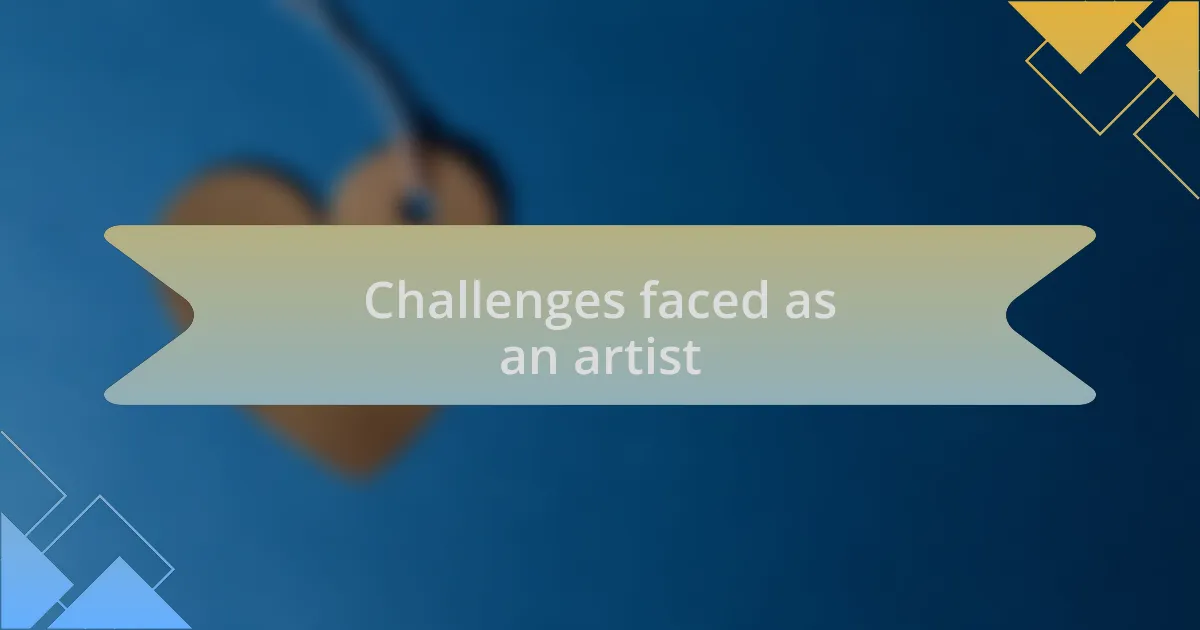
Challenges faced as an artist
Art is a beautiful journey, but it certainly isn’t without its obstacles. One of the most significant challenges I faced was self-doubt. I remember standing in front of my own sculptures, feeling a nagging voice in my head questioning my talent and direction. Have you ever felt that paralyzing fear that your work won’t be good enough? It took a lot of courage to push through those moments and remind myself that growth often comes from discomfort.
Financial instability is another harsh reality for many artists, myself included. There was a period where I struggled to balance my passion with the need to make a living. I recall taking on odd jobs—waiting tables, even selling handmade pieces at local markets—just to keep my art practice alive. Have you experienced the tension between art and financial stability? It’s a constant negotiation that can be emotionally taxing but essential for survival.
Then there’s the challenge of visibility in a saturated market. I often found myself feeling like a small fish in a vast ocean. It seemed like everyone was vying for attention, making it difficult to carve out my own niche. How do you stand out in such a crowded space? For me, the answer was to stay authentic to my artistic voice, even when the noise around me felt overwhelming. Engaging with my community and sharing my journey helped me build connections that ultimately led to greater recognition.

Turning passion into profession
Turning passion into a profession can feel like a daunting climb. I vividly remember the excitement I felt the first time someone purchased one of my sculptures. It was a validation that my passion could indeed flourish into something more sustainable. Have you ever experienced that electrifying moment when you realize your art resonates with others? It ignited a fire in me that compelled me to pursue art more seriously.
However, transforming this fervor into a profession requires a keen understanding of the business side of art. I had to figure out everything from pricing my work to marketing myself, which often felt overwhelming. I distinctly recall the late nights spent researching social media strategies to better showcase my portfolio. How do you find that balance between being an artist and a businessperson? For me, it was all about embracing learning as part of my creative journey.
As I navigated this transition, I learned the importance of persistence. Initially, facing rejection was tough; I still remember submitting my work to a gallery and receiving a swift “not this time.” It stung deeply, but instead of giving up, I used that disappointment as fuel to refine my craft. Do you remember a time when a setback pushed you to improve? In my experience, each rejection taught me more about my art and strengthened my resolve to keep pushing forward.
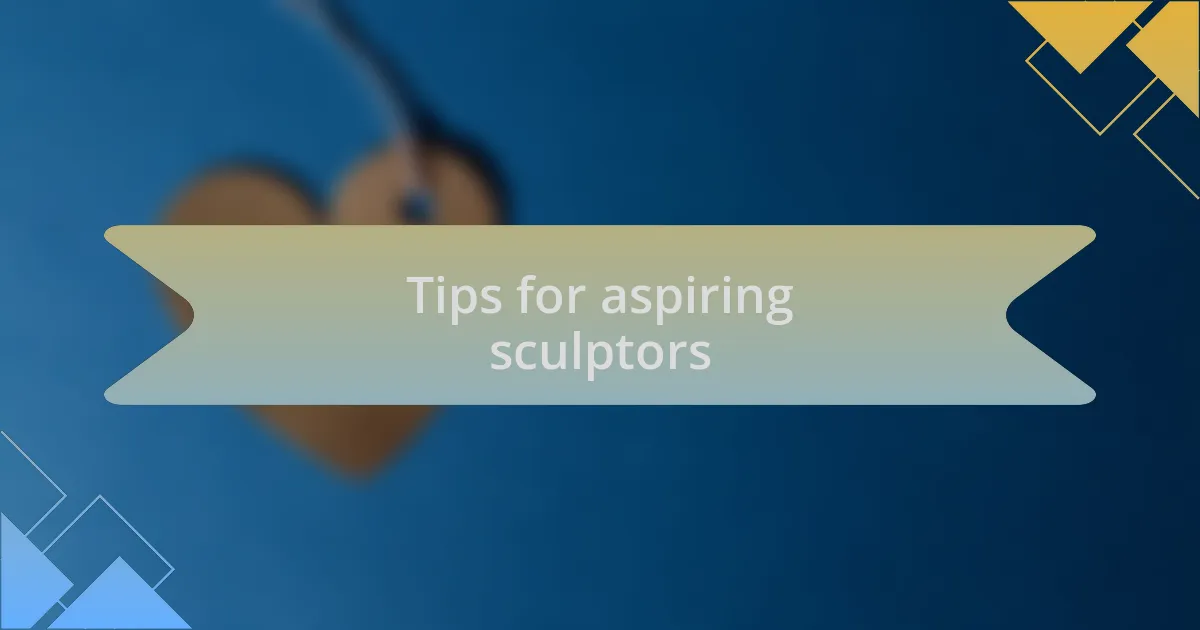
Tips for aspiring sculptors
Finding your unique style is crucial. I recall a period when I experimented with various mediums and techniques, seeking what felt authentic to my voice. It was only after countless messy sessions that I discovered my passion for combining clay with found objects. Have you ever felt the thrill of creating something wholly your own? Embrace that process; your individuality is what will truly set your work apart.
Building a network is equally important. I was quite shy in the beginning, struggling to connect with other artists and mentors. But when I finally stepped out, I found that sharing experiences and learning from others opened doors I never imagined. Have you thought about how collaboration could enhance your practice? Engaging with the art community can help you gain valuable insights and feedback that shape your trajectory.
Lastly, don’t underestimate the power of consistency. I established a routine, dedicating time each day to sculpting, no matter how small. There were days when the creative well felt dry, yet showing up for myself made all the difference. Have you committed to your craft regularly? I assure you, even those moments of frustration lead to breakthroughs that can deepen your artistic journey in unexpected ways.